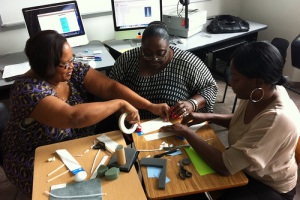Creating Constructive Collaboration

As my colleague Shen pointed out in her blog last week, a sense of community is critical for facilitating the learning process for both teachers and students. Unfortunately, community is not a word many teachers would use to describe their work; in fact, many teachers, who tend to focus on their classrooms and students, feel isolated from their colleagues. However, with the rising use of technology in the classroom to educate students more effectively, connect teachers broadly, and share data widely, collaboration has been highlighted as a panacea to the siloed role of teaching.
Not new to any educator’s lexicon, collaboration has become a buzzword as well as an actuality in education. Harvard and MIT are partnering in the knowledge-sharing platform, edX; non-profits are working together with schools to promote college and career readiness; and at recent conferences I’ve attended. several teachers spoke about their participation in collaborative professional learning communities within and outside of their school networks.
A community of like-minded peers working synchronously for a shared belief (towards a shared goal) requires processes that ensure that resources, such as attention, time, and effort, are used constructively and not wasted. To be most efficient actors need to work literally at the same table rather than asynchronously towards a single outcome.
A personal example happened in my college years, when a single national issue would spawn several new student organizations. If you were a student interested in eradicating civil injustice abroad, you could select from a menu of organizations. With minor differences, most of the organizations worked toward the same outcome. Yet rarely did they collaborate to strengthen their efforts; instead they competed for the precious attention and resources of students.
Recognizing the power of constructive criticism, several key education organizations – including College Summit, Center for Teaching Quality, Learning Forward, New Teacher Center, New Leaders, and The Education Trust – have been sharing resources, knowledge, and data over the past two years as part of a Knowledge Collaborative community led by ISKME. Recently, the Knowledge Collaborative has focused on the Common Core State Standards (CCSS). In September, the group will publish a series of blogs in Education Week that summarize and share insights from educators implementing the CCSS in their schools. In addition, teachers and administrators working with the partner organizations in the Knowledge Collaborative will provide CCSS implementation tips for educators; offer important CCSS information for parents; and describe how districts can support new teachers during the process. The Knowledge Collaborative aims not only to collaborate among themselves but also to facilitate collaboration within schools and across states by highlighting how each education stakeholder – teachers, principals, districts, parents, and non-profits – is integral to the success of the CCSS implementation.
Constructive collaboration works best when all involved voices are at the table. As educators begin to work together across broader platforms and adoption of technologies facilitate virtual collaboration, conversations about education will become louder and more synchronous. These synchronous conversations, occurring as a result of constructive collaboration, will improve conditions for learning by increasing the efficiency of processes, elevating the quality of resources, and focusing the attention of educators on a unified vision for enhancing student achievement.




